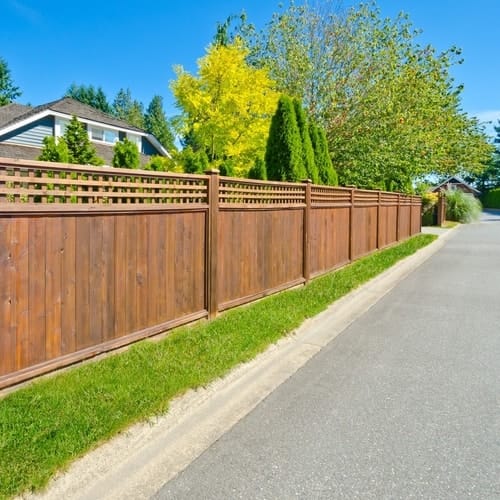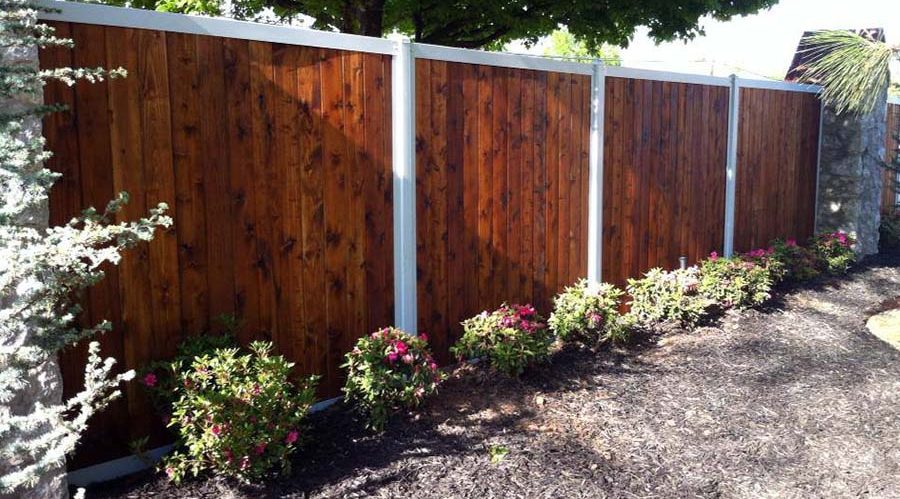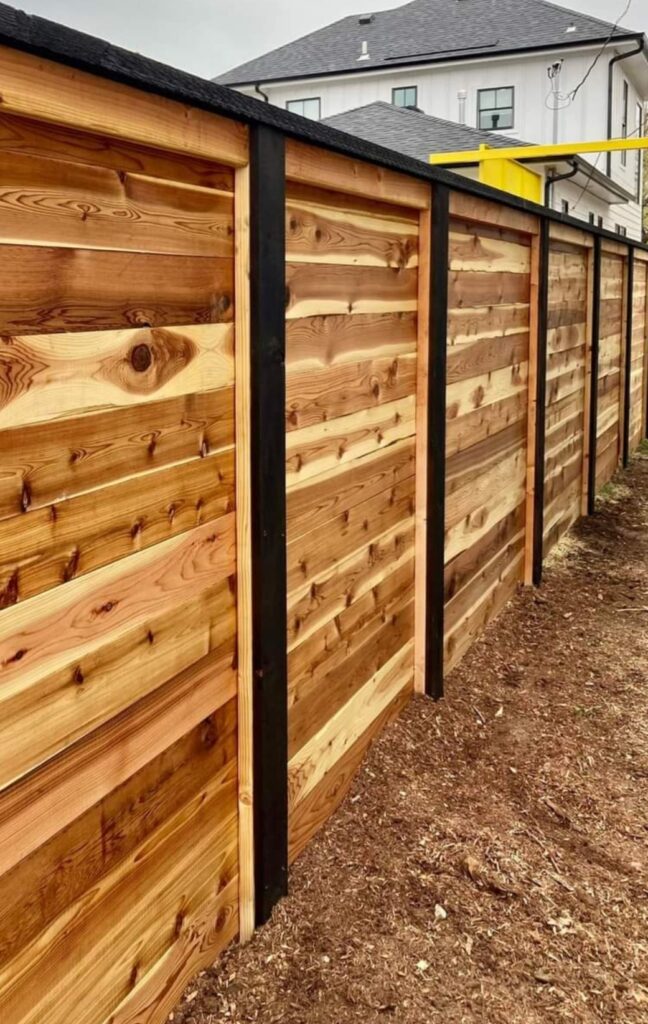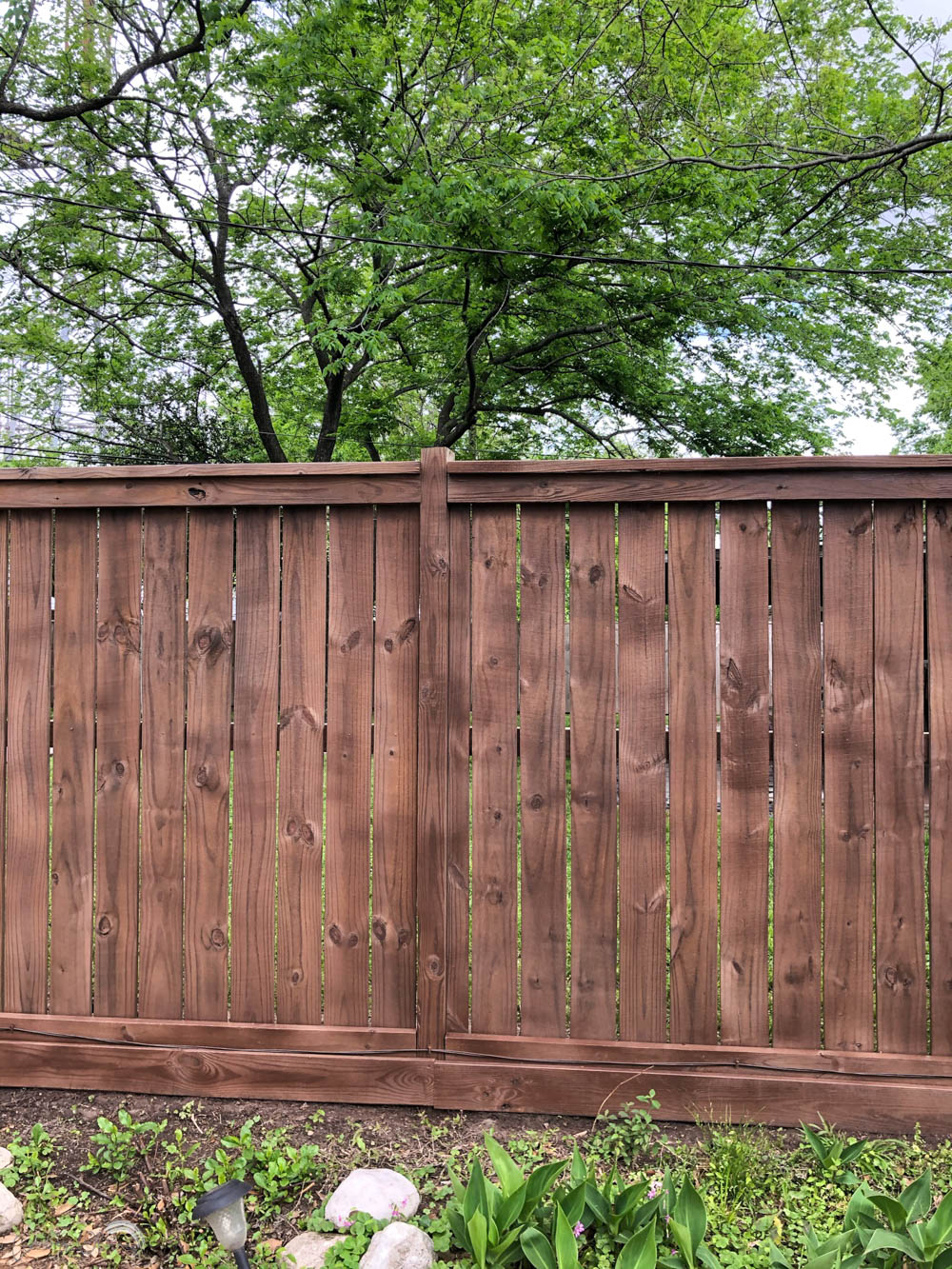Are you looking to give your fence a fresh look? Want to add some color and style to your outdoor space? Well, you’re in luck because I have some fantastic fence staining ideas for you! In this article, we’ll dive into the world of fence staining and explore different options to transform your fence into a beautiful focal point in your yard. Whether you’re looking for a natural and rustic look or a vibrant pop of color, we’ve got you covered. So, let’s get started and revamp your fence with these creative staining ideas!
When it comes to fence staining, the possibilities are endless. One popular option is the classic cedar stain, which enhances the natural beauty of the wood and gives it a warm, rich color. This is a great choice if you want to maintain a more traditional and timeless look for your fence. Another idea is to use a transparent or semi-transparent stain, which allows the natural grain of the wood to show through while adding a touch of color. This is perfect if you want to preserve the wood’s natural beauty while giving it a subtle makeover. If you’re feeling more adventurous, you can go for a bold and vibrant stain color like red, blue, or green. This is a fantastic way to add personality and a unique touch to your fence.
So, are you excited to learn more about these fence staining ideas? In the upcoming article, we’ll delve deeper into each idea and provide you with step-by-step instructions on how to achieve the desired look. We’ll also discuss the best types of stains to use and share some pro tips to ensure a successful staining project. Get ready to transform your fence and create a fresh new look for your outdoor space! Stay tuned for more exciting fence staining ideas coming your way!
Fence Staining Ideas for a Fresh Look
Fence staining is not only about protecting your fence from the elements, but it also presents an opportunity to enhance the overall aesthetic appeal of your outdoor space. Whether you want to preserve the natural beauty of the wood or add a pop of color, there are various staining techniques and ideas to choose from. In this article, we will explore different fence staining ideas that can give your fence a fresh and updated look.

Common Types of Fence Stains
Before diving into the staining ideas, it’s important to understand the different types of fence stains available. Each type offers unique benefits and characteristics that cater to different needs and preferences.
Oil-based Stains for Long-lasting Results
Oil-based stains are known for their durability and long-lasting protection. These stains penetrate deep into the wood, providing a strong barrier against moisture and UV rays. They also enhance the natural beauty of the wood by showcasing its grain and texture. Oil-based stains typically require more time for drying but offer excellent resistance against weathering and fading.
Water-based Stains for Environmental Friendliness
If you prefer an environmentally friendly staining option, water-based stains are a great choice. These stains are low in volatile organic compounds (VOCs), making them safer for both the environment and the individuals applying the stain. Water-based stains are easy to clean up and dry quickly, allowing for a faster application process. They also offer a wide range of color options and provide good UV protection for the wood.
Semi-transparent Stains for Natural Wood Look
Semi-transparent stains strike a balance between color and showcasing the natural beauty of the wood. These stains add a hint of color while still allowing the wood grain to shine through. They offer a more natural and rustic look, making them ideal for fences built with visually appealing wood species, such as cedar or redwood.
Solid Stains for Bold Color
If you’re looking to add a bold pop of color to your fence, solid stains are the way to go. These stains provide maximum color coverage, effectively hiding the natural wood grain. Solid stains are available in a variety of vibrant hues, allowing you to match them with your home’s exterior or create a striking contrast. They also provide excellent protection against the sun’s UV rays and require less maintenance compared to paint.
Choosing the Right Color for Your Fence Stain
Now that you’re familiar with the different types of stains, it’s time to choose the right color for your fence stain. The color you select can significantly impact the overall look and feel of your outdoor space. Here are some factors to consider when deciding on the perfect color:
Considering Your Home’s Exterior
Your fence should complement the overall look of your home’s exterior. Take a close look at the existing color scheme of your house and choose a stain color that harmonizes with it. If your home has a neutral palette, consider using warm or cool-toned stain colors that blend well with the surroundings. If you have a more vibrant exterior, don’t be afraid to experiment with contrasting colors to create a visually appealing statement.
Matching the Fence with the Landscape
Consider the surrounding landscape when selecting a fence stain color. Take into account the colors of your plants, flowers, and other outdoor elements. For instance, if you have a lush green garden, a natural wood tone stain can create a harmonious look. On the other hand, if your landscape features various vibrant colors, a bolder stain color can make your fence stand out as a focal point.
Choosing a Color Scheme for a Cohesive Look
To achieve a cohesive look throughout your outdoor space, consider choosing a color scheme that incorporates your fence stain color. This will create a sense of unity and harmony. You can coordinate the stain color with your outdoor furniture, patio accessories, or the color of your exterior walls. A well-planned color scheme will tie all the elements together, creating a visually pleasing and inviting atmosphere.

Preparing Your Fence for Staining
Before beginning the staining process, it’s crucial to prepare your fence properly. Proper preparation ensures that the stain adheres well, leading to a long-lasting finish. Here are the key steps involved in preparing your fence for staining:
Cleaning the Fence Surface
Begin by thoroughly cleaning the fence surface to remove dirt, grime, and any loose debris. Using a gentle detergent and a scrub brush, scrub the entire fence, paying special attention to any areas with stubborn stains or mold growth. Rinse the fence with a hose to remove all the soap residue and allow it to dry completely before proceeding to the next step.
Removing Old Stain or Paint
If your fence has an existing stain or paint, it’s important to remove it before applying a new stain. There are several methods for removing old stain or paint from a fence, including sanding, pressure washing, or using a chemical stripper. Choose the method that is most suitable for your fence material and follow the manufacturer’s instructions carefully.
Repairing Damaged or Loose Boards
Inspect the entire fence for any damaged or loose boards. If you come across any, take the time to repair or replace them before staining. This ensures that your fence is structurally sound and ready to withstand the staining process as well as the elements.
Applying a Wood Brightener
After cleaning and repairing the fence, consider applying a wood brightener. Wood brighteners help to restore the natural color of the wood and remove any stains or discoloration caused by exposure to the elements. Follow the manufacturer’s instructions on how to apply the brightener and allow it to dry before proceeding with the staining process.
Tools and Materials Needed for Staining
To ensure a successful staining project, gather all the necessary tools and materials beforehand. Here are the essential items you’ll need:
Brushes and Rollers for Application
Depending on the size and layout of your fence, choose either brushes or rollers for applying the stain. Brushes are ideal for intricate and hard-to-reach areas, while rollers are more efficient for larger fence sections. Opt for high-quality brushes and rollers to ensure smooth and even coverage.
Sprayers for Large Fence Areas
If you have a large fence area to cover, consider using a sprayer for easier and faster application. Sprayers are particularly useful for applying stain evenly on rough or textured surfaces. However, they may require more time for preparation and cleanup compared to brushes or rollers.
Protective Gear for Safety
Staining a fence involves working with chemicals and pigments, so it’s important to prioritize safety. Wear protective gear, such as gloves, safety glasses, and a respirator, to protect your skin, eyes, and lungs from potential hazards. Additionally, wear appropriate clothing that you don’t mind getting stained.
Stain and Sealant Products
Select high-quality stain and sealant products for a long-lasting and durable finish. Consider the type of stain that suits your needs and the color that matches your desired aesthetic. Ensure that the sealant offers UV protection and water resistance to protect your fence from the elements.

Step-by-Step Guide to Staining Your Fence
Now that you have everything you need, let’s dive into a step-by-step guide on how to stain your fence effectively:
Clearing the Fence Area
Clear the fence area of any obstacles, such as plants, furniture, or garden decorations. This will ensure an obstruction-free workspace and prevent accidental staining of unwanted items.
Applying Masking Tape for Neat Edges
If you want clean and crisp edges, apply masking tape along the edges of your fence, such as where it meets the house or the ground. This will create a clear boundary for the stain and prevent any accidental overspill onto adjacent surfaces.
Starting from the Top and Working Down
Begin staining your fence from the top and work your way down. This prevents any drips or stains from falling onto already stained areas, resulting in a more even and professional finish.
Evenly Applying the Stain
Using a brush, roller, or sprayer, evenly apply the stain in long and smooth strokes. Work in small sections at a time to ensure that the stain doesn’t dry before you’ve had a chance to spread it evenly. Avoid applying too much stain in one area, as this can lead to pooling and an uneven appearance.
Allowing Sufficient Drying Time
Once you have completed staining the entire fence, allow sufficient drying time before touching or placing any objects near the fence. Follow the manufacturer’s instructions on drying times and avoid exposing the freshly stained fence to any moisture or direct sunlight until it has fully cured.
Tips for Achieving a Professional Fence Stain
To achieve a professional-looking fence stain, consider implementing the following tips:
Test the Stain on a Small Area First
Before staining the entire fence, test the stain on a small and inconspicuous area. This will give you a clear idea of how the stain will react to your fence material and whether it’s the right color choice for your desired look.
Avoid Overlapping Strokes for Smooth Coverage
When applying the stain, be mindful of overlapping strokes. Overlapping too much can result in a thicker layer of stain in certain areas, leading to an uneven appearance. Work in small sections and ensure that each stroke is consistent and even.
Maintain Consistent Pressure and Speed
To achieve a uniform finish, maintain a consistent pressure and speed while applying the stain. This ensures that the stain is spread evenly and prevents any visible variation in color or texture.
Avoid Staining in Direct Sunlight
Try to avoid staining your fence in direct sunlight, especially on hot days. The heat can cause the stain to dry too quickly, resulting in lap marks and an uneven finish. It’s best to work in cooler temperatures or during mornings or evenings when the sun is less intense.

Maintenance and Care for Stained Fences
To keep your stained fence looking fresh and vibrant, regular maintenance and care are essential. Here are some tips for maintaining and caring for your stained fence:
Regular Inspections and Touch-Ups
Periodically inspect your fence for any signs of wear, such as cracks, peeling, or fading. Address any issues promptly by performing touch-ups or recoating the affected areas to extend the life of your stain and maintain its visual appeal.
Cleaning Mildew or Mold Growth
If you notice mildew or mold growth on your stained fence, clean it as soon as possible to prevent further damage. Use a mixture of water and mild detergent or a specialized fence cleaner to gently scrub away the growth. Rinse thoroughly and allow the fence to dry completely before considering any further treatment.
Reapplying Stain as Needed
Over time, the stain on your fence may start to fade or wear off. When this occurs, it’s time to reapply the stain. Follow the same preparation and application process outlined earlier to ensure a consistent and long-lasting finish.
Protecting Against Weather Damage
To protect your stained fence from weather damage, consider applying a protective sealant every few years. This will help to maintain the integrity of the stain, prevent water penetration, and provide additional UV protection.
Staining Techniques for Different Fence Materials
Different fence materials require specific staining techniques to achieve the desired look and durability. Here are some staining techniques for popular fence materials:
Staining Cedar Fences for Natural Beauty
Cedar is a popular choice for fences due to its natural beauty and durability. To stain a cedar fence, opt for a semi-transparent stain that allows the wood’s natural color and grain to show through. Apply the stain evenly, keeping in mind that cedar absorbs stain quickly, so working in small sections is essential for a consistent appearance.
Staining Treated Pine for Enhanced Durability
Treated pine fences are often chosen for their affordability and resistance to rot and insects. When staining treated pine, it’s important to allow the wood to dry thoroughly before applying the stain. Treated pine tends to have a greenish tint, so selecting a stain color that complements or masks this undertone is recommended.
Staining Metal Fences for Rust Prevention
Metal fences, such as wrought iron or aluminum, can benefit from stain application as well. However, instead of traditional wood stains, metal fences require specialized coatings designed to prevent rust and corrosion. These coatings typically come in a variety of colors and finishes, allowing you to customize the look of your metal fence while simultaneously protecting it from the elements.
Staining Vinyl Fences for Color Customization
Vinyl fences are known for their low maintenance and durability. While vinyl fences don’t necessarily require staining for protection, staining is an option for those looking to customize their fence color. Vinyl-specific stains are available and can be applied to achieve a desired hue while maintaining the original benefits of vinyl, such as resistance to fading and cracking.

Creative Fence Staining Ideas
Looking for a unique and creative way to spruce up your fence? Consider these fence staining ideas to add visual interest and charm to your outdoor space:
Two-Tone Fence Stains for Visual Interest
Create a visually appealing fence by using two-tone stains. Apply a lighter or darker shade of stain to alternate pickets or segments of your fence. This technique adds depth and dimension to your fence, making it a standout feature in your yard.
Stenciled Patterns for Aesthetic Appeal
Transform your fence into a work of art by using stencils to create patterns or designs. Stencils can be used to create intricate motifs, geometric shapes, or even personalized monograms. Choose a contrasting stain color for the stenciled design, and carefully apply the stain within the stencil for a striking and eye-catching finish.
Color Fading Techniques for Vintage Look
Add a rustic and vintage charm to your fence by using color fading techniques. Start with a bold stain color and gradually fade it along the length of the fence for a gradient effect. This technique gives the impression of weathered wood, adding character and a touch of nostalgia to your outdoor space.
Benefits of Staining Your Fence
Staining your fence offers numerous benefits beyond just its visual appeal. Here are some advantages of fence staining:
Protection Against UV Rays and Moisture
Stain provides a protective barrier to prevent the sun’s UV rays from fading or damaging your fence. Additionally, stain helps to repel moisture, preventing the wood from rotting or warping over time. By staining your fence, you extend its lifespan and keep it looking fresh and new for longer.
Enhanced Aesthetic Appeal
One of the primary reasons for staining a fence is to enhance its aesthetic appeal. Stains come in a wide variety of colors, finishes, and opacities, allowing you to customize the look of your fence to suit your personal style and the overall theme of your outdoor space. A well-stained fence instantly adds beauty and curb appeal to your property.
Increased Lifespan of the Fence
Staining your fence significantly increases its lifespan by protecting it from the elements. The stain acts as a shield, preventing water damage, rot, and insect infestation. By investing in regular maintenance and staining, you can ensure that your fence stands strong and remains in excellent condition for many years to come.
Common Mistakes to Avoid When Staining a Fence
To achieve the best results when staining your fence, it’s important to avoid common mistakes that can compromise the quality and appearance of the finished product. Here are some mistakes to avoid:
Not Cleaning or Preparing the Fence Properly
Proper cleaning and preparation are essential for a successful staining project. Failing to remove dirt, mold, or old stain can prevent the new stain from adhering properly and lead to an uneven finish. Take the time to thoroughly clean and prepare your fence to ensure optimal stain application.
Using Incorrect Stain Type for the Fence Material
Different fence materials require specific stain types for optimal results. Using the wrong stain can lead to poor adhesion, color inconsistency, or premature fading. Research the best stain options for your specific fence material and consult with professionals if needed to ensure you choose the appropriate stain.
Applying Stain in Poor Weather Conditions
Staining your fence in unfavorable weather conditions can negatively impact the staining process and the final result. Avoid staining when it’s too hot, too cold, or in direct sunlight. Extreme temperatures can affect the stain’s drying time, while direct sunlight can cause the stain to dry too quickly, resulting in lap marks or an uneven finish. Choose a day with mild temperatures and little to no wind for the best staining conditions.
Costs Involved in Fence Staining
When considering staining your fence, it’s important to understand the associated costs. Several factors can influence the overall cost of a fence staining project, including the size of the fence, the condition of the wood, the type of stain and sealant used, and whether you choose to hire professionals or tackle the project yourself. Here’s a breakdown of the costs involved:
Factors Affecting the Cost of Staining
- Fence size: The larger the fence, the more stain and materials will be required, increasing the overall cost.
- Fence condition: If your fence requires extensive cleaning, repairs, or stripping of old stain, additional time and resources will be needed, impacting the cost.
- Stain and sealant type: High-quality stains and sealants generally cost more than lower-grade options. Factors like the brand, durability, and specific features of the stain can affect the price.
- Hiring professionals vs DIY: Hiring professionals will incur labor costs, while staining the fence yourself can save money but requires time and effort on your part.
Average Price Range for Professional Fence Staining
On average, the cost of hiring professionals to stain a fence can range from $3 to $8 per square foot. However, keep in mind that the total cost may vary depending on the factors mentioned above, regional differences, and the specific pricing of the staining contractor you choose. Obtaining multiple quotes and comparing the services and prices of different professionals will help you make an informed decision.
DIY vs. Hiring a Professional: Cost Comparison
If you decide to tackle the fence staining project yourself, the cost will generally be lower but require your time and effort. DIY staining costs will primarily be incurred through purchasing the necessary tools and materials, such as stain, brushes, rollers, and protective gear. Be sure to factor in your time and any additional expenses related to cleaning, repairs, or equipment rentals. Conducting thorough research and obtaining accurate cost estimates will help you determine whether DIY or hiring professionals is the more cost-effective option for your situation.
Comparing Stain vs. Paint for Fences
When it comes to enhancing the look of your fence, you may also consider painting as an alternative to staining. Each option has its pros and cons, so it’s important to understand the differences before making a decision.
Pros and Cons of Staining a Fence
Pros:
- Enhances the natural beauty and texture of the wood.
- Provides a more rustic and natural appearance.
- Penetrates the wood, offering better protection against moisture and UV rays.
- Requires less maintenance and touch-ups compared to paint.
Cons:
- Color options may be more limited compared to paint.
- Wood grain and imperfections may still be visible.
Pros and Cons of Painting a Fence
Pros:
- Offers a wide variety of color options and finish choices.
- Can provide a smoother and more uniform appearance.
- Can completely cover imperfections and wood grain.
- Creates a solid barrier against moisture and UV rays.
Cons:
- Requires more maintenance as paint tends to chip or peel over time.
- May require more preparation and priming compared to staining.
Choosing the Right Option for Your Needs
The decision between staining and painting your fence ultimately depends on your personal preferences, the desired outcome, and the specific characteristics of your fence. If you prefer a more natural and rustic look that enhances the wood’s grain, staining is the way to go. On the other hand, if you want to add vibrant color or completely cover up imperfections, painting might be the better choice. Consider your priorities, the maintenance level you’re willing to commit to, and the overall aesthetic you wish to achieve when deciding between stain and paint for your fence.
Conclusion
Staining your fence is a fantastic way to protect it from the elements while adding visual interest to your outdoor space. By choosing the right stain type and color, preparing the fence properly, and utilizing creative staining techniques, you can achieve a fresh and updated look for your fence. Remember to prioritize regular maintenance, avoid common staining mistakes, and carefully compare the costs and benefits of staining options and painting alternatives. With the right care and attention, your stained fence will not only last longer but also become a focal point that enhances the overall beauty of your property.
